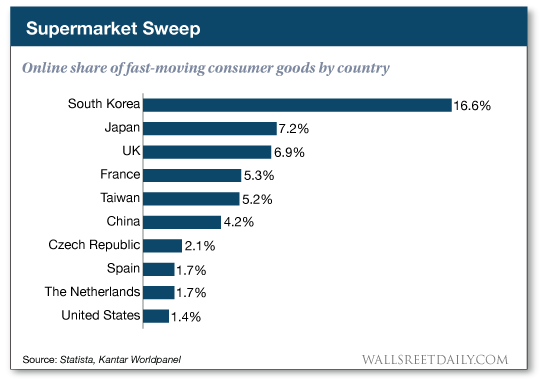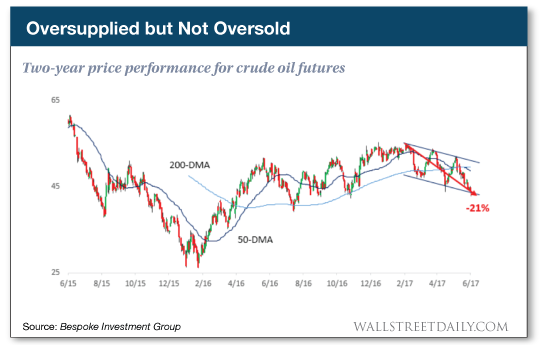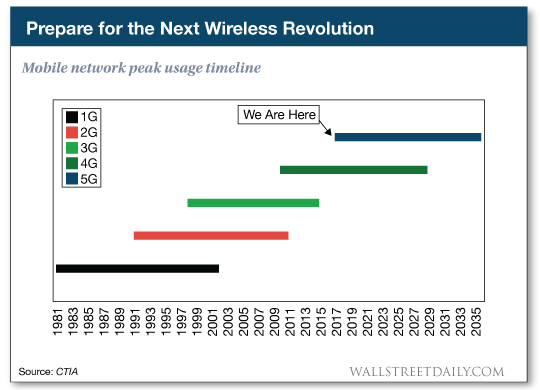Friday Charts: Amazon, Oil And The World’s Fastest Wireless Network
It’s Friday in the Wall Street Daily nation. For the neophytes in our ranks, that means it’s time to break free from our regular routine.
Instead of just flapping my gums ad nauseum, I’m employing a handful of graphics to help convey some important insights.
Specifically, I’m serving up more evidence to support my bold claim that Amazon.com Inc.’s (AMZN) acquisition of Whole Foods Market, Inc. (WFM) is all about data, not overpriced organic vegetables and kombucha.
Then it’s on to a cautionary tale from the tape in the energy sector.
Last but not least, I’m serving up proof why now is the ideal time to start positioning your portfolio to profit from the multitrillion-dollar buildout of the next-generation of wireless communications networks.
So without further ado…
Nothing but a Data Point
On Tuesday, I insisted that Amazon’s interest in Whole Foods was all about customer data. The more the company can get its hands on, the more stuff it can ultimately sell to customers.
Like it or not… If you’re a Whole Foods Customer, you’re now a data point for Amazon.
That’s no longer my conjecture, either. It’s confirmed.
Business Insider reports that the acquisition gives Amazon access to “unprecedented brick-and-mortar shopping data.”
Moreover, 62% of Whole Foods shoppers have an Amazon Prime account, according to a survey by Morgan Stanley.
The ginormous overlap all but guarantees that Amazon is going to mine the data to discover the shopping tendencies of its Prime customers to tailor future advertising campaigns.
So if you’re a Whole Foods and Amazon Prime customer, hold tight to your wallet. It’s going to get a whole lot harder to resist the product ads coming your way.
As I said, the primary motivation for the acquisition is about getting us to buy more stuff. But of course, it’s also about the obvious: Amazon will dominate an entirely new market. In this case, online grocery shopping.
As this chart demonstrates, there’s a lot of opportunity to dominate still. Online grocery shopping remains a nascent industry in the United States, accounting for only 1.4% of total online sales for fast-moving consumer goods.

In comparison, South Korea checks in at a 16.6% penetration rate.
Naturally, the quickest way for Amazon to broaden its reach and close that gap with South Korea is by buying, not building a network of grocery store locations in the U.S.
Mission accomplished!
As for investors, like I’ve said before, don’t bet against Bezos!
If you’re looking to make a bearish bet, you should consider oil instead…
Look out Below
Oil prices dropped to a seven-month low earlier in the week on more oversupply concerns.
The latest leg down means the commodity officially entered bear-market territory.

“Oil is in a downtrend and risks trending into the $30s,” says Paul Ciana, a technical strategist at Bank of America Merrill Lynch.
How low will prices go?
Based on an analysis of the last 36 bear markets for oil, Bespoke Investment Group notes that there could be another 14% downside if this is an average bear market.
Translation? Odds are in your favor if you want to short the commodity. Or if you’re looking to buy the dip in the oil patch — whether it’s the commodity itself or actual operating companies — hold off a little longer. You’ll likely get a chance to do so at even cheaper prices soon…
Inflection Point Ahead
At the start of 2017, I told True Alpha subscribers to start positioning their portfolios to profit from the crazy-fast data technology of 5G wireless networks. (5G networks promise to offer 10–100 times faster data speeds and lower latency.)
Please understand, this recommendation flew in the face of conventional wisdom because most analysts believed any 5G deployments, and therefore any real profit opportunities, wouldn’t start until next year.
They were wrong!
Since the beginning of the year, Verizon (VZ) confirmed that it’s going to trial with 5G networks in 11 U.S. cities this year! AT&T (T) also announced its making initial rollouts this year.
According to a new study from the China Academy of Information and Communications Technology, China’s telecoms are preparing to spend a combined $411 billion on building out 5G networks.
As you can see on this chart, we’re approaching a major multiyear inflection point. Don’t miss out!

If you don’t know what stocks to buy, consider a risk-free trial to our premium advisory here. Our pure-play small-cap recommendation on 5G networks is already up 36%. But the gains are just getting started.
Not to mention, we’ve identified four other small caps destined to benefit from the explosion in 5G networks.
Disclaimer: Wall Street Daily is committed to protecting and respecting your privacy. We do not rent or share your email address. By submitting your email address, you consent to Agora Financial ...
more



thanks